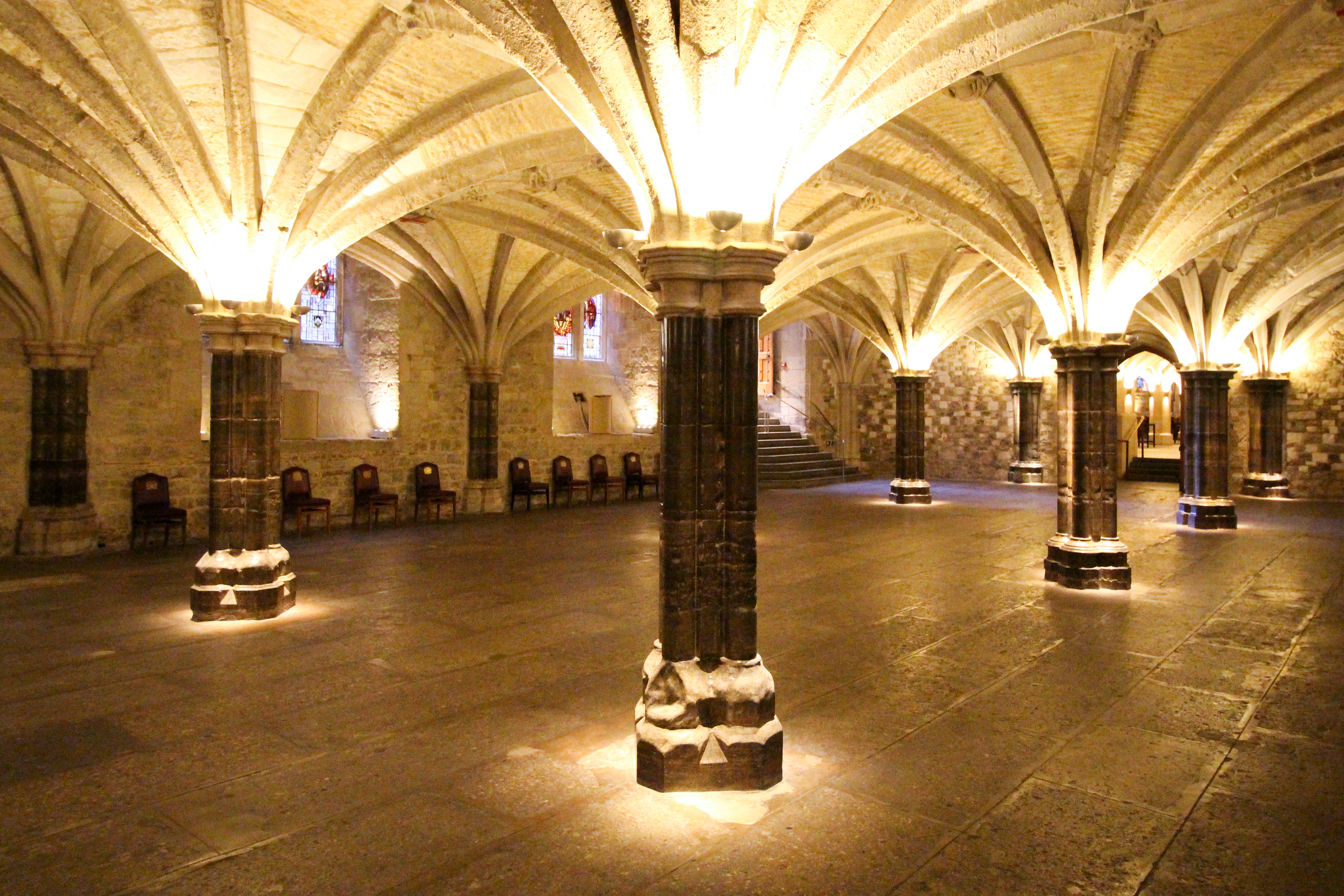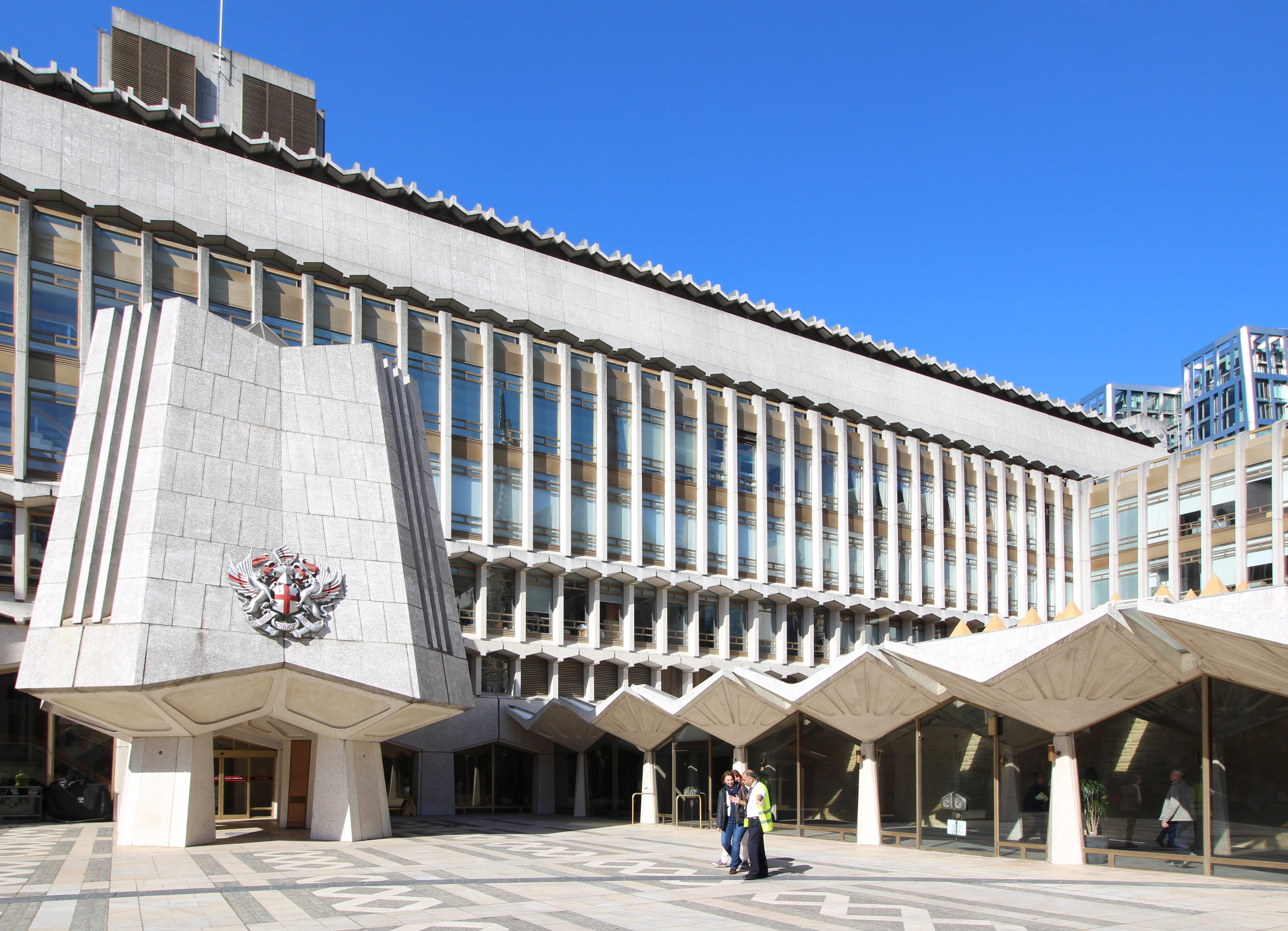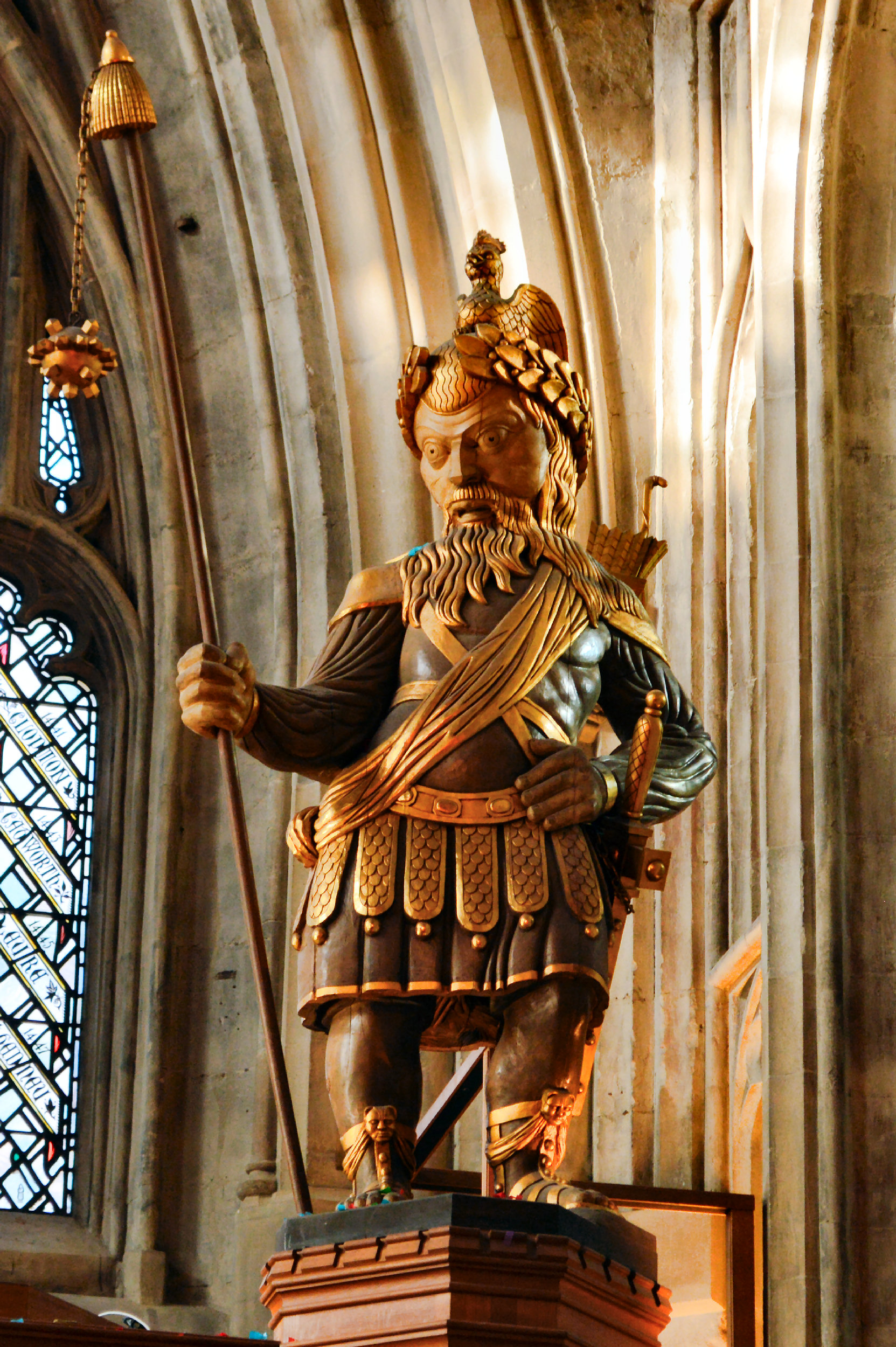Guildhall, London on:
[Wikipedia]
[Google]
[Amazon]
Guildhall is a municipal building in the Moorgate area of the
 During the
During the
 The current building began construction in 1411 and completed in 1440.
The current building began construction in 1411 and completed in 1440.

 The Great Hall did not completely escape damage in the Great Fire of London in 1666; it was partially restored (with a flat roof) in 1670. The present grand entrance (the east wing of the south front), in " Hindoostani Gothic", was added in 1788 by George Dance. A more extensive restoration than that in 1670 was completed in 1866 by the City of London architect Sir Horace Jones, who added a new timber roof in close keeping with the original hammerbeam ceiling. This replacement was destroyed during the
The Great Hall did not completely escape damage in the Great Fire of London in 1666; it was partially restored (with a flat roof) in 1670. The present grand entrance (the east wing of the south front), in " Hindoostani Gothic", was added in 1788 by George Dance. A more extensive restoration than that in 1670 was completed in 1866 by the City of London architect Sir Horace Jones, who added a new timber roof in close keeping with the original hammerbeam ceiling. This replacement was destroyed during the
 The day-to-day administration of the City of London Corporation is now conducted from modern buildings immediately to the north of Guildhall, but Guildhall itself and the adjacent historic interiors are still used for official functions, and it is open to the public during the annual London Open House weekend. Guildhall Art Gallery was added to the complex in the 1990s. Guildhall Library, a public reference library with specialist collections on London, which include material from the 11th century onwards, is also housed in the complex.
The day-to-day administration of the City of London Corporation is now conducted from modern buildings immediately to the north of Guildhall, but Guildhall itself and the adjacent historic interiors are still used for official functions, and it is open to the public during the annual London Open House weekend. Guildhall Art Gallery was added to the complex in the 1990s. Guildhall Library, a public reference library with specialist collections on London, which include material from the 11th century onwards, is also housed in the complex.
 Two giants, Gog and Magog, are associated with Guildhall. Legend has it that the two giants were defeated by Brutus and chained to the gates of his palace on the site of Guildhall. Early carvings of Gog and Magog were destroyed in Guildhall during the Great Fire of London. They were replaced in 1708 by a large pair of wooden statues carved by Captain Richard Saunders. These giants, on whom the current versions are based, lasted for more than two hundred years before they were destroyed in the Blitz. They, in turn, were replaced by a new pair carved by David Evans in 1953 and given to the City of London by
Two giants, Gog and Magog, are associated with Guildhall. Legend has it that the two giants were defeated by Brutus and chained to the gates of his palace on the site of Guildhall. Early carvings of Gog and Magog were destroyed in Guildhall during the Great Fire of London. They were replaced in 1708 by a large pair of wooden statues carved by Captain Richard Saunders. These giants, on whom the current versions are based, lasted for more than two hundred years before they were destroyed in the Blitz. They, in turn, were replaced by a new pair carved by David Evans in 1953 and given to the City of London by
City of London Corporation homepage on Guildhall
{{Authority control 1411 establishments in England Government buildings completed in 1440 Grade I listed buildings in the City of London Local government buildings in London Tourist attractions in the City of London History of the City of London Buildings and structures in the United Kingdom destroyed during World War II City and town halls in London Georgian architecture in London Gothic architecture in England Roman London Gog and Magog
City of London
The City of London is a city, ceremonial county and local government district that contains the historic centre and constitutes, alongside Canary Wharf, the primary central business district (CBD) of London. It constituted most of London f ...
, England
England is a country that is part of the United Kingdom. It shares land borders with Wales to its west and Scotland to its north. The Irish Sea lies northwest and the Celtic Sea to the southwest. It is separated from continental Europe ...
. It is off Gresham and Basinghall streets, in the wards of Bassishaw and Cheap. The building has been used as a town hall for several hundred years, and is still the ceremonial and administrative centre of the City of London and its Corporation
A corporation is an organization—usually a group of people or a company—authorized by the state to act as a single entity (a legal entity recognized by private and public law "born out of statute"; a legal person in legal context) and ...
. It should not be confused with London's City Hall
In local government, a city hall, town hall, civic centre (in the UK or Australia), guildhall, or a municipal building (in the Philippines), is the chief administrative building of a city, town, or other municipality. It usually houses ...
, the administrative centre for Greater London. The term "Guildhall" refers both to the whole building and to its main room, which is a medieval great hall. The nearest London Underground stations are Bank
A bank is a financial institution that accepts Deposit account, deposits from the public and creates a demand deposit while simultaneously making loans. Lending activities can be directly performed by the bank or indirectly through capital m ...
, St Paul's and Moorgate. It is a Grade I-listed building.
History
Roman, Saxon and Medieval
 During the
During the Roman
Roman or Romans most often refers to:
* Rome, the capital city of Italy
* Ancient Rome, Roman civilization from 8th century BC to 5th century AD
*Roman people, the people of ancient Rome
*''Epistle to the Romans'', shortened to ''Romans'', a lett ...
period, the Guildhall was the site of the London Roman Amphitheatre, rediscovered as recently as 1988. It was the largest in Britannia
Britannia () is the national personification of Britain as a helmeted female warrior holding a trident and shield. An image first used in classical antiquity, the Latin ''Britannia'' was the name variously applied to the British Isles, Grea ...
, partial remains of which are on public display in the basement of the Guildhall Art Gallery, and the outline of whose arena is marked with a black circle on the paving of the courtyard in front of the hall. Indeed, the siting of the Saxon Guildhall here was probably due to the amphitheatre's remains. Excavations by Museum of London Archaeology at the entrance to Guildhall Yard exposed remains of the great 13th-century gatehouse built directly over the southern entrance to the Roman amphitheatre, which raises the possibility that enough of the Roman structure survived to influence the siting not only of the gatehouse and Guildhall itself but also of the church of St Lawrence Jewry whose strange alignment may shadow the elliptical form of the amphitheatre beneath.
The first documentary reference to a London Guildhall is dated 1128. Legend describes the Guildhall site as being the location of the palace of Brutus of Troy
Brutus, also called Brute of Troy, is a legendary descendant of the Trojan hero Aeneas, known in medieval British history as the eponymous founder and first king of Britain. This legend first appears in the '' Historia Brittonum'', an anony ...
, who according to Geoffrey of Monmouth's ''Historia Regum Britanniae
''Historia regum Britanniae'' (''The History of the Kings of Britain''), originally called ''De gestis Britonum'' (''On the Deeds of the Britons''), is a pseudohistorical account of British history, written around 1136 by Geoffrey of Monmouth. ...
'' (1136) is said to have founded a city on the banks of the River Thames, known as Troia Nova, or New Troy.
The great hall is believed to be on a site of an earlier guildhall (one possible derivation for the word "guildhall" is the Anglo-Saxon "gild", meaning payment, with a "gild-hall" being where citizens would pay their taxes). Possible evidence for this derivation may be in a reference to John Parker, the sergeant of "Camera Guyhalde", London, in 1396.
Current building
 The current building began construction in 1411 and completed in 1440.
The current building began construction in 1411 and completed in 1440.

 The Great Hall did not completely escape damage in the Great Fire of London in 1666; it was partially restored (with a flat roof) in 1670. The present grand entrance (the east wing of the south front), in " Hindoostani Gothic", was added in 1788 by George Dance. A more extensive restoration than that in 1670 was completed in 1866 by the City of London architect Sir Horace Jones, who added a new timber roof in close keeping with the original hammerbeam ceiling. This replacement was destroyed during the
The Great Hall did not completely escape damage in the Great Fire of London in 1666; it was partially restored (with a flat roof) in 1670. The present grand entrance (the east wing of the south front), in " Hindoostani Gothic", was added in 1788 by George Dance. A more extensive restoration than that in 1670 was completed in 1866 by the City of London architect Sir Horace Jones, who added a new timber roof in close keeping with the original hammerbeam ceiling. This replacement was destroyed during the Second Great Fire of London
The Second Great Fire of London in December 1940 was caused by one of the most destructive air raids of the Blitz during World War II. The Luftwaffe raid caused fires over an area greater than that of the Great Fire of London in 1666, leading o ...
on the night of 29/30 December 1940, the result of a Luftwaffe
The ''Luftwaffe'' () was the aerial-warfare branch of the German '' Wehrmacht'' before and during World War II. Germany's military air arms during World War I, the '' Luftstreitkräfte'' of the Imperial Army and the '' Marine-Fliegerabt ...
fire-raid. It was replaced in 1954 during works designed by Sir Giles Gilbert Scott, though the original hammerbeam design was not retained.
Trials at the Guildhall have included those of Anne Askew (the Protestant martyr), Thomas Cranmer
Thomas Cranmer (2 July 1489 – 21 March 1556) was a leader of the English Reformation and Archbishop of Canterbury during the reigns of Henry VIII, Edward VI and, for a short time, Mary I. He helped build the case for the annulment of Hen ...
(Archbishop of Canterbury) and Lady Jane Grey ("the Nine Days' Queen") as well as Henry Garnet (executed for his complicity in the Gunpowder Plot of 1605).
The 1783 hearing of the infamous ''Zong'' case, the outcome of which focused public outrage about the transatlantic slave trade, also took place at Guildhall. On 16 November 1848, the pianist Frédéric Chopin made his last public appearance on a concert platform there. The marathon route of the 2012 Summer Olympics
The 2012 Summer Olympics (officially the Games of the XXX Olympiad and also known as London 2012) was an international multi-sport event held from 27 July to 12 August 2012 in London, England, United Kingdom. The first event, th ...
passed through Guildhall Yard.
Present use
 The day-to-day administration of the City of London Corporation is now conducted from modern buildings immediately to the north of Guildhall, but Guildhall itself and the adjacent historic interiors are still used for official functions, and it is open to the public during the annual London Open House weekend. Guildhall Art Gallery was added to the complex in the 1990s. Guildhall Library, a public reference library with specialist collections on London, which include material from the 11th century onwards, is also housed in the complex.
The day-to-day administration of the City of London Corporation is now conducted from modern buildings immediately to the north of Guildhall, but Guildhall itself and the adjacent historic interiors are still used for official functions, and it is open to the public during the annual London Open House weekend. Guildhall Art Gallery was added to the complex in the 1990s. Guildhall Library, a public reference library with specialist collections on London, which include material from the 11th century onwards, is also housed in the complex.
Gog and Magog
 Two giants, Gog and Magog, are associated with Guildhall. Legend has it that the two giants were defeated by Brutus and chained to the gates of his palace on the site of Guildhall. Early carvings of Gog and Magog were destroyed in Guildhall during the Great Fire of London. They were replaced in 1708 by a large pair of wooden statues carved by Captain Richard Saunders. These giants, on whom the current versions are based, lasted for more than two hundred years before they were destroyed in the Blitz. They, in turn, were replaced by a new pair carved by David Evans in 1953 and given to the City of London by
Two giants, Gog and Magog, are associated with Guildhall. Legend has it that the two giants were defeated by Brutus and chained to the gates of his palace on the site of Guildhall. Early carvings of Gog and Magog were destroyed in Guildhall during the Great Fire of London. They were replaced in 1708 by a large pair of wooden statues carved by Captain Richard Saunders. These giants, on whom the current versions are based, lasted for more than two hundred years before they were destroyed in the Blitz. They, in turn, were replaced by a new pair carved by David Evans in 1953 and given to the City of London by Alderman
An alderman is a member of a municipal assembly or council in many jurisdictions founded upon English law. The term may be titular, denoting a high-ranking member of a borough or county council, a council member chosen by the elected members ...
Sir George Wilkinson, who had been Lord Mayor in 1940 at the time of the destruction of the previous versions.
Functions
Guildhall hosts many events throughout the year, the most notable one being the Lord Mayor's Banquet, which is held in honour of the immediate-past Lord Mayor and is the first to be hosted by the new Lord Mayor of the City of London. In keeping with tradition, it is at this banquet that thePrime Minister
A prime minister, premier or chief of cabinet is the head of the cabinet and the leader of the ministers in the executive branch of government, often in a parliamentary or semi-presidential system. Under those systems, a prime minister is ...
makes a major world affairs speech. One of the last acts of the outgoing Lord Mayor is to present prizes at the City of London School prize day at Guildhall. Other events include those of various law firms, award evenings for the Wine and Spirit Education Trust
The Wine & Spirit Education Trust, often referred to as WSET, is a global organisation which arranges courses and exams in the field of wine, spirits and sake. WSET was founded in 1969, is headquartered in London and is generally regarded as one ...
(WSET), and the banquet for the International Wine and Spirit Competition
The International Wine & Spirit Competition is an annual wine and spirit competition founded in 1969 by the German/British oenologist Anton Massel. Each year the competition receives entries from over 90 countries worldwide. The awards given by t ...
(IWSC). The Worshipful Company of Carmen holds its cart-marking ceremony in the courtyard each July.
Guildhall Bar
The members' bar in the Guildhall is a highly subsidised facility for members of the Court of Common Council and the Court of Aldermen. However, access to the facilities is a privilege for life, even after an individual ceases to be a member of either of these courts. Members can also entertain guests there. It is substantially cheaper than any other bar in theCity of London
The City of London is a city, ceremonial county and local government district that contains the historic centre and constitutes, alongside Canary Wharf, the primary central business district (CBD) of London. It constituted most of London f ...
, as it is subsidised from the City's Cash, a sovereign wealth fund.
See also
*Guild
A guild ( ) is an association of artisans and merchants who oversee the practice of their craft/trade in a particular area. The earliest types of guild formed as organizations of tradesmen belonging to a professional association. They sometim ...
* Guildhall
A guildhall, also known as a "guild hall" or "guild house", is a historical building originally used for tax collecting by municipalities or merchants in Great Britain and the Low Countries. These buildings commonly become town halls and in some ...
References
External links
City of London Corporation homepage on Guildhall
{{Authority control 1411 establishments in England Government buildings completed in 1440 Grade I listed buildings in the City of London Local government buildings in London Tourist attractions in the City of London History of the City of London Buildings and structures in the United Kingdom destroyed during World War II City and town halls in London Georgian architecture in London Gothic architecture in England Roman London Gog and Magog